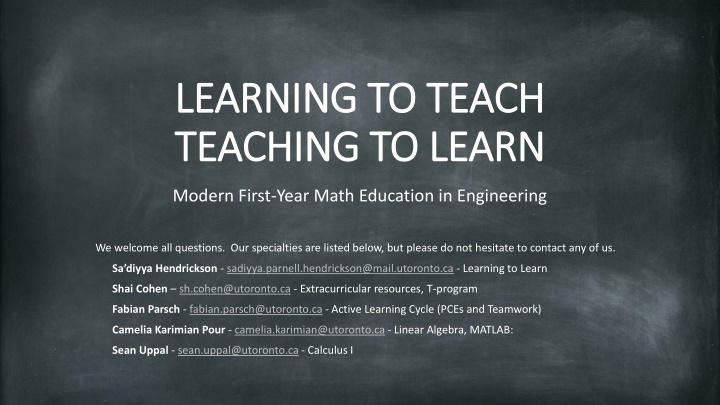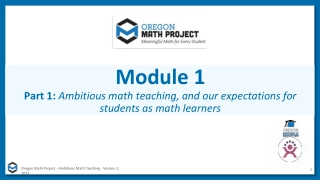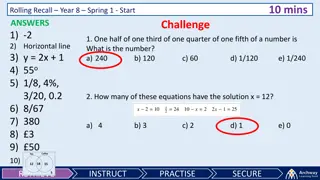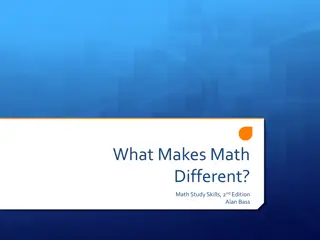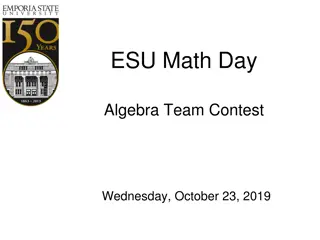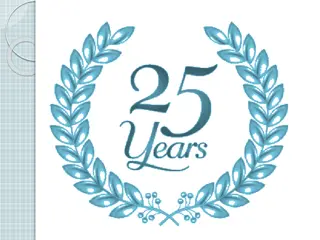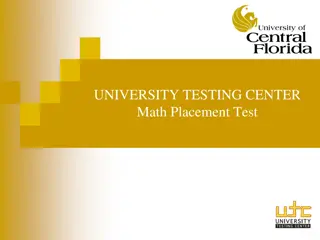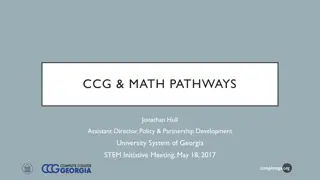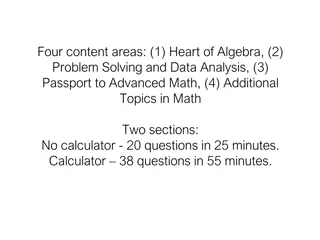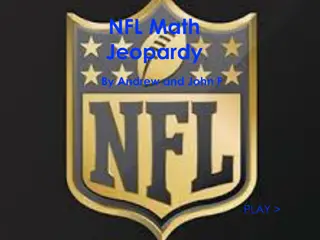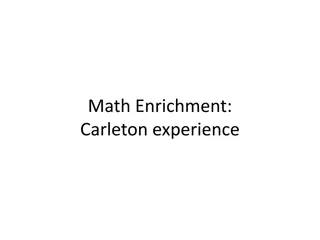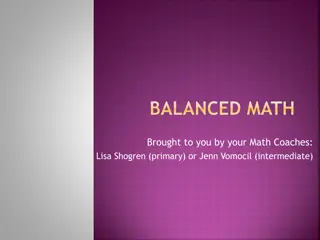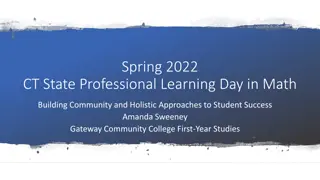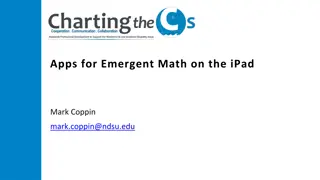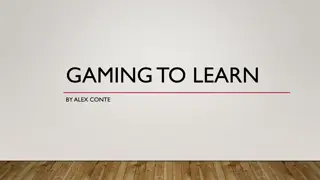Evolution of First-Year Math Education in Engineering
First-year math courses in engineering have undergone significant changes over the past decade, focusing on concepts over computations, promoting multiple paths to success, prioritizing qualitative results, incorporating mathematical modeling and problem-solving, enhancing collaboration and communication, and employing active learning strategies to support students with diverse mathematical backgrounds and experiences.
Download Presentation

Please find below an Image/Link to download the presentation.
The content on the website is provided AS IS for your information and personal use only. It may not be sold, licensed, or shared on other websites without obtaining consent from the author.If you encounter any issues during the download, it is possible that the publisher has removed the file from their server.
You are allowed to download the files provided on this website for personal or commercial use, subject to the condition that they are used lawfully. All files are the property of their respective owners.
The content on the website is provided AS IS for your information and personal use only. It may not be sold, licensed, or shared on other websites without obtaining consent from the author.
E N D
Presentation Transcript
LEARNING TO TEACH LEARNING TO TEACH TEACHING TO LEARN TEACHING TO LEARN Modern First-Year Math Education in Engineering We welcome all questions. Our specialties are listed below, but please do not hesitate to contact any of us. Sa diyya Hendrickson - sadiyya.parnell.hendrickson@mail.utoronto.ca - Learning to Learn Shai Cohen sh.cohen@utoronto.ca - Extracurricular resources, T-program Fabian Parsch - fabian.parsch@utoronto.ca - Active Learning Cycle (PCEs and Teamwork) Camelia Karimian Pour - camelia.karimian@utoronto.ca - Linear Algebra, MATLAB: Sean Uppal - sean.uppal@utoronto.ca - Calculus I
Purpose Of This Presentation We are teachers and coordinators of the first year math courses for Core 8 from the Department of Mathematics and ISTEP We wish to ...make the faculty more aware of the changes in the first-year mathematics courses in FASE over the past decade and demonstrate what additional resources would further support student learning in this new framework. ...showcase the most recent changes and the direction in which they lead. ...begin discussions about what other courses, in first year and in later years, feel has worked and what they think can be done to improve our efforts. 2
The Setting Course code Course title Semester Enrollment APS 162 Calculus I Summer ~150 APS 163 Calculus II Fall ~60 MAT 186 Calculus I Fall ~850 MAT 188 Linear Algebra Fall ~1000 MAT 187 Calculus II Winter ~950 MAT 186T Calculus I Winter ~50 MAT 188T Linear Algebra Winter ~50 MAT 187T Calculus II Summer ~80 3
Student Context We are teaching students with diverse mathematical background with very different lived experiences Rather frequently, we encounter less mathematical maturity the idea that math is about plug and chug and following recipes ingrained passive learning practices lack of learning skills feelings of anxiety and being overwhelmed 4
Program Wide Changes Concepts over computations Multiple paths to success Qualitative results over quantitative results Less tentpole assignments with heavy weight Mathematical modeling and problem-solving Regular engagement with material Standard- and attribute-based grading Resources added Collaboration and communication Better TA/student ratio Teamwork Math Success Program Writing mathematics Math self-assessment Math as a language ePUMP (Preparing for University Math Program) Assigned seating in MY150 5
The Active Learning Cycle Note: PCE = Pre-Class Essentials 6
Calculus II A quote from the syllabus: We want to train you in the art of teamwork and communication. As future engineers, you will serve an important role at the boundary between science and its applications. You will have to talk to business partners, manufacturers, designers, construction workers, investors. You will need to be able not just to arrive at correct mathematical answers but make others understand you, believe you, and trust you. 7
Calculus II 2022 Term Test 1 - Numerical integration A quote from the syllabus: We want to train you in the art of teamwork and communication. As future engineers, you will serve an important role at the boundary between science and its applications. You will have to talk to business partners, manufacturers, designers, construction workers, investors. You will need to be able not just to arrive at correct mathematical answers but make others understand you, believe you, and trust you. 8
Linear Algebra Instructor support Mastery-based grading Lecture tasks Standardgrading in tutorials Learning standards Online gateway exams MATLAB projects (project 2, Fall 2022) 10
Concerns And Requests Assessments Workload concerns We aim to teach skills and virtues that are not easy to assess via traditional exams Not enough time to properly treat the concepts and no time to learn to retain Modern assessments (Gateway exams, standard-based grading) requires resources and flexible policies For example, in Linear Algebra: from vectors in 2D to singular value decomposition + MATLAB in one term Possible solutions Linear Algebra I and II + MATLAB A year-long separate course on MATLAB 11
The Counterpart: Teaching To Learn The teaching of the courses has been improved, but we can also show the students how to become improved learners. Learning how to learn Through open and explicit communication, we can: Foster a productive disposition the understanding that math is a learned skill and is fundamental to becoming a better engineer. Help students become self-regulated learners This is already happening in subtle ways in our courses, but there is great benefit in making Learning How to Learn an explicit part of our course structures. 12
Examples Fostering productive disposition: Providing materials that address: students experiences and mental health university resources the nature of math and how to learn it active learning and its benefits Supporting self-regulated learners: Offering resources that include: math-specific learning strategies pre-class, in-class, and after-class training checklists Learning How to Learn (LHL) corner in lecture slides how to get math help outside of class tutorials that reinforce active learning practices 13
Examples Fostering productive disposition: Providing materials that address: students experiences and mental health university resources the nature of math and how to learn it active learning and its benefits Supporting self-regulated learners: Offering resources that include: math-specific learning strategies pre-class, in-class, and after-class training checklists Learning How to Learn (LHL) corner in lecture slides how to get math help outside of class tutorials that reinforce active learning practices 14
Examples Fostering productive disposition: Providing materials that address: students experiences and mental health university resources the nature of math and how to learn it active learning and its benefits Supporting self-regulated learners: Offering resources that include: math-specific learning strategies pre-class, in-class, and after-class training checklists Learning How to Learn (LHL) corner in lecture slides how to get math help outside of class tutorials that reinforce active learning practices 15
Examples Fostering productive disposition: Providing materials that address: students experiences and mental health university resources the nature of math and how to learn it active learning and its benefits Supporting self-regulated learners: Offering resources that include: math-specific learning strategies pre-class, in-class, and after-class training checklists Learning How to Learn (LHL) corner in lecture slides how to get math help outside of class tutorials that reinforce active learning practices 16
Next steps: some conversation starters Help students prepare for the university learning experience by integrating in-class support of learning skills, existing and additional external resources, and peer support groups. Adopt new policies on grades that strengthen incentives for struggling students to find and use available resources. Create a dialogue with students across their courses that discusses active learning, aiming to reduce their frustration and resistance. 17
LEARNING TO TEACH LEARNING TO TEACH TEACHING TO LEARN TEACHING TO LEARN Modern First-Year Math Education in Engineering Thank you! Camelia Karimian Pour Shai Cohen Sa diyya Hendrickson Fabian Parsch Sean Uppal
